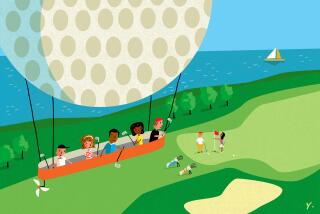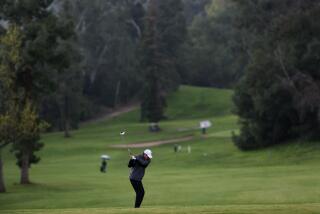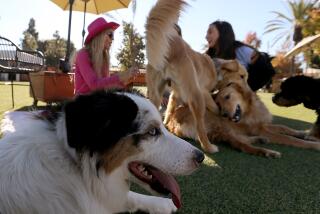Tee It Up
From the pro shop at Mason Park in Irvine--really nothing more than a trailer in the parking lot--the attendant calls out to two golfers walking toward him, waving what looks like . . . a Frisbee?
“I got my sixth ace yesterday,” said Mike Keenan, showing off the memento from the hole in one.
At Mason Park, it’s golf in name only; everything else has been changed. In disc golf, the holes are baskets. There are no defined fairways and the players don’t have clubs. Instead of balls, there are hard plastic discs.
But the challenge is similar: you still have to battle hooks and slices and sink your putts. And a bogey is a bogey any way you look at it.
However, disc golf might be more user-friendly than the traditional game. You don’t have to battle the masses to secure a tee time and, perhaps best of all, it’s easier to learn.
“It’s a quicker learning curve than regular golf,” said Mike Balliet, president of Mission Viejo-based Disc Sports Management. “You can get the hang of it in the first disc or two.”
Balliet’s company is promoting the sport in Southern California by building courses and setting up pro shops at existing ones. Balliet helped design and build the course in Mason Park, which will host the Mason Park Open--a Professional Disc Golf Assn. event--on Aug. 28-29.
Yes, there’s a professional tour--the PDGA estimates there are 12,000 pros among the 80,000 disc golfers worldwide. There are courses in 17 countries, and five in Orange County. The one in Huntington Beach’s Central Park is one of the oldest: it opened in 1977, one year after the sport was invented.
Mason Park is the county’s newest, opening in March. One recent weekday afternoon Balliet and two friends, Vince Bartolone and John Tomsick, headed there for a round.
At the first tee--really just a line drawn in the grass--the three tote golf bags, about the size of backpacks and available for $25 at the pro shop. Each carries 15 discs, about the size of garden variety Frisbees, although flatter and a little heavier.
There are “drivers,” which are designed to fly farther. There are the “irons,” which the players use for approach shots, and the “putters,” which have rounder edges and are designed for accuracy.
Regular discs cost $8, premium discs $10, or a set of discs can be rented for $2.
“I carry four putters for different reasons,” said Bartolone, opening his bag like someone selling watches on a street corner. “I know these two will hold the line. These two will fly a little more.”
They tee off at the first hole, a 370-foot hole, one of the 17 par threes on the course. The other--hole No. 2--is a par four. Balliet takes a running start at the line and as his drive sails a little off-course he yells “fore,” catching the attention of two park goers doing sit-ups next to a tree.
“I was just going to grip it and rip it,” Balliet said, shaking his head.
The course isn’t set up with fairways or greens. Hazards can be anywhere. That is shown on the first hole, where the basket is tucked between a tree and a creek. To get around the tree, Balliet uses a “hyzer,” or a right-to-left shot much like a draw or hook on a standard golf course. The disc golfer’s fade or slice is the “anhyzer.”
“I have no idea why they call it that,” Balliet said, shrugging.
There is also the tomahawk shot, which is over the shoulder and into the air, and the scooby roller, which is also over the shoulder, but with a wrist snap to make the disc roll on the ground toward the target.
Eventually, each golfer tosses his disc into the first basket, a contraption with a metal basket--the disc catcher--that sits about three feet off the ground and is about three feet in diameter. Above it is a chandelier of chains at which the golfers aim, in hopes that their putt will fall into the basket.
“Some [park goers] ask, ‘Is that some kind of a barbecue?’ ” Balliet said. “They wonder why the tin foil keeps falling in.”
The golfers move along, talking about things like the disc golf resort in Port Arthur, Texas; the effectiveness of the roller drive, where the object is to get the disc to roll on its side and avoid trees; Tomsick’s ace on the 14th hole earlier in the week, when he skipped the disc on the ground and underneath the trees to get to the basket; and other chatter.
On the 17th hole, there is a bit of a snag. Bartolone takes a second drive--”I just do that for the practice,” he said--and it hits high in a tree and gets stuck. Five minutes later, the disc is retrieved when one of the golfers is boosted up with a stick to dislodge the disc. The golfers play on.
They speak of the fun of the sport, and its difference from “ball golf.” Cost is the most obvious difference. Most disc courses are free; the Mason and Central park courses charge $1 to play the entire day.
Equipment is also much cheaper. A full bag of premium discs is only $150, about half the cost of a titanium driver.
“You don’t have to be independently wealthy to play,” said Balliet, who also plays traditional golf.
Balliet said the average age of disc golfers at Mason Park is 30, and since a round takes only 45 minutes to an hour to finish, it can be a family sport.
“We just hope that it’s a sport that’s ready to catch on,” Balliet said. “We’re trying to get people to just come out and try. For every three that try, we hope we get one that sticks with it.”
At the end of the round, Bartolone’s disc hits the side of the basket and falls to the ground, evoking the same groan that comes when a golfer lips out a putt. Disc golf is not without its own frustrations.
“Oh, well,” Bartolone said with a sigh. “I guess that’s just the way the disc bounces.”
More to Read
Go beyond the scoreboard
Get the latest on L.A.'s teams in the daily Sports Report newsletter.
You may occasionally receive promotional content from the Los Angeles Times.










